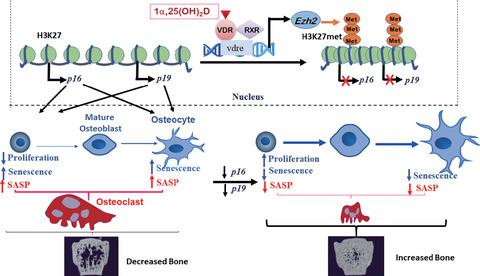当前位置:
X-MOL 学术
›
Aging Cell
›
论文详情
Our official English website, www.x-mol.net, welcomes your feedback! (Note: you will need to create a separate account there.)
1,25-Dihydroxyvitamin D protects against age-related osteoporosis by a novel VDR-Ezh2-p16 signal axis.
Aging Cell ( IF 7.8 ) Pub Date : 2019-12-26 , DOI: 10.1111/acel.13095 Renlei Yang 1, 2 , Jie Chen 3 , Jiao Zhang 2 , Ran Qin 2 , Rong Wang 2 , Yue Qiu 2 , Zhiyuan Mao 2 , David Goltzman 4 , Dengshun Miao 1, 2
Aging Cell ( IF 7.8 ) Pub Date : 2019-12-26 , DOI: 10.1111/acel.13095 Renlei Yang 1, 2 , Jie Chen 3 , Jiao Zhang 2 , Ran Qin 2 , Rong Wang 2 , Yue Qiu 2 , Zhiyuan Mao 2 , David Goltzman 4 , Dengshun Miao 1, 2
Affiliation

|
To determine whether 1,25‐dihydroxyvitamin D (1,25(OH)2D) can exert an anti‐osteoporosis role through anti‐aging mechanisms, we analyzed the bone phenotype of mice with 1,25(OH)2D deficiency due to deletion of the enzyme, 25‐hydroxyvitamin D 1α‐hydroxylase, while on a rescue diet. 1,25(OH)2D deficiency accelerated age‐related bone loss by activating the p16/p19 senescence signaling pathway, inhibiting osteoblastic bone formation, and stimulating osteoclastic bone resorption, osteocyte senescence, and senescence‐associated secretory phenotype (SASP). Supplementation of exogenous 1,25(OH)2D3 corrected the osteoporotic phenotype caused by 1,25(OH)2D deficiency or natural aging by inhibiting the p16/p19 pathway. The proliferation, osteogenic differentiation, and ectopic bone formation of bone marrow mesenchymal stem cells derived from mice with genetically induced deficiency of the vitamin D receptor (VDR) were significantly reduced by mechanisms including increased oxidative stress, DNA damage, and cellular senescence. We also demonstrated that p16 deletion largely rescued the osteoporotic phenotype caused by 1,25(OH)2D3 deficiency, whereas 1,25(OH)2D3 could up‐regulate the enzyme Ezh2 via VDR‐mediated transcription thereby enriching H3K27me3 and repressing p16/p19 transcription. Finally, we demonstrated that treatment with 1,25(OH)2D3 improved the osteogenic defects of human BM‐MSCs caused by repeated passages by stimulating their proliferation and inhibiting their senescence via the VDR‐Ezh2‐p16 axis. The results of this study therefore indicate that 1,25(OH)2D3 plays a role in preventing age‐related osteoporosis by up‐regulating Ezh2 via VDR‐mediated transcription, increasing H3K27me3 and repressing p16 transcription, thus promoting the proliferation and osteogenesis of BM‐MSCs and inhibiting their senescence, while also stimulating osteoblastic bone formation, and inhibiting osteocyte senescence, SASP, and osteoclastic bone resorption.
中文翻译:

1,25-二羟基维生素D通过新颖的VDR-Ezh2-p16信号轴防止与年龄有关的骨质疏松症。
为了确定1,25-二羟基维生素D(1,25(OH)2 D)是否可以通过抗衰老机制发挥抗骨质疏松作用,我们分析了1,25(OH)2 D缺乏引起的小鼠的骨表型在急救饮食中删除25-羟基维生素D1α-羟化酶。1,25(OH)2 D缺乏症通过激活p16 / p19衰老信号通路,抑制成骨细胞形成并刺激破骨细胞骨吸收,骨细胞衰老和衰老相关的分泌表型(SASP)来加速与年龄有关的骨质流失。补充外源1,25(OH)2 D 3可纠正由1,25(OH)2引起的骨质疏松症表型D缺乏症或自然衰老可通过抑制p16 / p19途径来实现。通过氧化应激,DNA损伤和细胞衰老等机制,可显着减少源自具有遗传诱导的维生素D受体(VDR)缺乏症的小鼠的骨髓间充质干细胞的增殖,成骨分化和异位骨形成。我们还证明p16缺失在很大程度上挽救了1,25(OH)2 D 3缺乏引起的骨质疏松症表型,而1,25(OH)2 D 3可以通过VDR介导的转录上调酶Ezh2,从而丰富H3K27me3和抑制p16 / p19转录。最后,我们证明了用1,25(OH)2 D 3处理通过刺激其增殖并通过VDR-Ezh2-p16轴抑制其衰老,改善了人类BM-MSC反复传代引起的成骨缺陷。因此,本研究结果表明1,25(OH)2 D 3通过通过VDR介导的转录上调Ezh2,增加H3K27me3并抑制p16转录来预防年龄相关的骨质疏松症,从而促进增殖和成骨抑制BM-MSC并抑制其衰老,同时还刺激成骨细胞的形成,并抑制骨细胞的衰老,SASP和破骨细胞的骨吸收。
更新日期:2019-12-26
中文翻译:

1,25-二羟基维生素D通过新颖的VDR-Ezh2-p16信号轴防止与年龄有关的骨质疏松症。
为了确定1,25-二羟基维生素D(1,25(OH)2 D)是否可以通过抗衰老机制发挥抗骨质疏松作用,我们分析了1,25(OH)2 D缺乏引起的小鼠的骨表型在急救饮食中删除25-羟基维生素D1α-羟化酶。1,25(OH)2 D缺乏症通过激活p16 / p19衰老信号通路,抑制成骨细胞形成并刺激破骨细胞骨吸收,骨细胞衰老和衰老相关的分泌表型(SASP)来加速与年龄有关的骨质流失。补充外源1,25(OH)2 D 3可纠正由1,25(OH)2引起的骨质疏松症表型D缺乏症或自然衰老可通过抑制p16 / p19途径来实现。通过氧化应激,DNA损伤和细胞衰老等机制,可显着减少源自具有遗传诱导的维生素D受体(VDR)缺乏症的小鼠的骨髓间充质干细胞的增殖,成骨分化和异位骨形成。我们还证明p16缺失在很大程度上挽救了1,25(OH)2 D 3缺乏引起的骨质疏松症表型,而1,25(OH)2 D 3可以通过VDR介导的转录上调酶Ezh2,从而丰富H3K27me3和抑制p16 / p19转录。最后,我们证明了用1,25(OH)2 D 3处理通过刺激其增殖并通过VDR-Ezh2-p16轴抑制其衰老,改善了人类BM-MSC反复传代引起的成骨缺陷。因此,本研究结果表明1,25(OH)2 D 3通过通过VDR介导的转录上调Ezh2,增加H3K27me3并抑制p16转录来预防年龄相关的骨质疏松症,从而促进增殖和成骨抑制BM-MSC并抑制其衰老,同时还刺激成骨细胞的形成,并抑制骨细胞的衰老,SASP和破骨细胞的骨吸收。


























 京公网安备 11010802027423号
京公网安备 11010802027423号